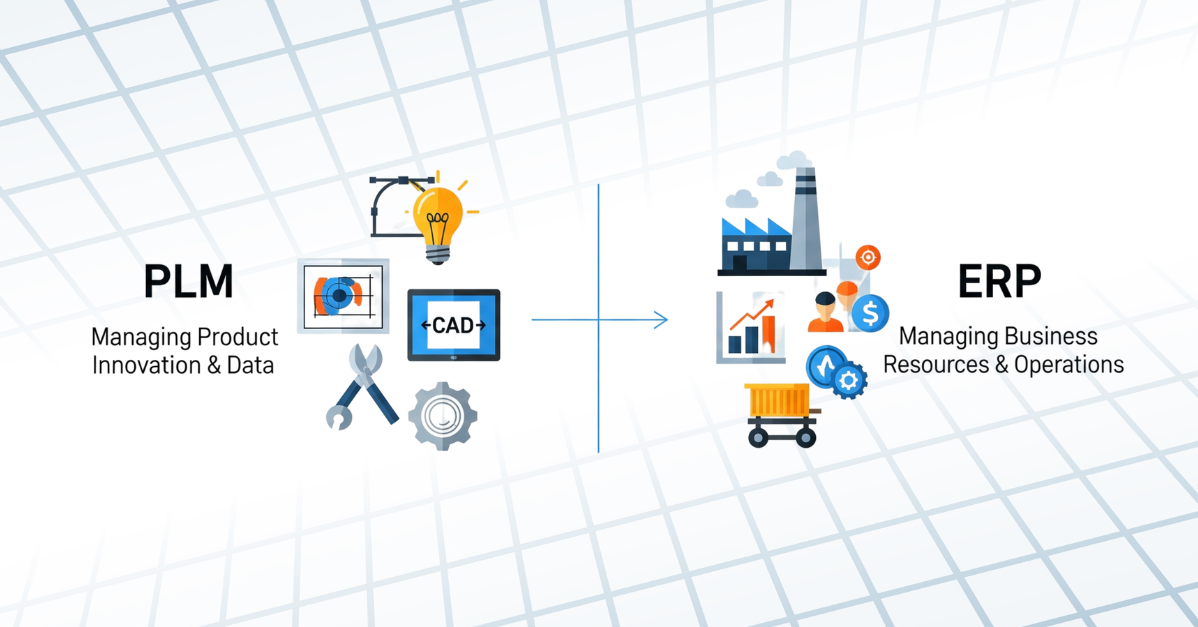In the world of digital manufacturing, PLM and ERP systems are often mentioned in the same conversations. Both are essential for efficient operations—but they’re designed to do very different things.
Understanding the difference between Product Lifecycle Management (PLM) and Enterprise Resource Planning (ERP) is critical for any company trying to improve speed, accuracy, and collaboration across the product lifecycle.
What Is PLM?
PLM software is focused on managing the product itself—its design, engineering, documentation, and ongoing evolution. It’s where product data lives, where changes are tracked, and where engineering teams collaborate.
Key functions of PLM include:
- Managing CAD data and file versions
- Controlling engineering changes (ECRs, ECOs)
- Creating and managing Bills of Materials (BOMs)
- Creating digital threads by linking product data across different functions and systems
By serving as a single source of truth for engineering and product information, PLM reduces errors, shortens time to market, and supports innovation. In many systems, PLM also enables the creation of a digital twin—a virtual representation of the product that evolves alongside the physical asset.
What Is ERP?
ERP software, on the other hand, manages business operations—things like inventory, procurement, accounting, logistics, and production scheduling.
Key ERP functions include:
- Materials planning and procurement
- Manufacturing execution and shop floor control
- Inventory and warehouse management
- Order fulfillment and financial reporting
ERP ensures that the right materials are ordered, produced, and shipped on time. But it relies on accurate product data—often coming from PLM.
PLM vs ERP: Where They Intersect
Think of PLM as upstream and ERP as downstream. PLM helps you design and define the product; ERP helps you build and deliver it.
Without PLM, companies often struggle to manage complex product changes. Without ERP, they may lack visibility into operations and cost.
Together, PLM and ERP form a closed-loop system—from concept to production to delivery. But they must be connected intentionally.
Why Integration Between PLM and ERP Matters
Misalignment between PLM and ERP leads to real-world consequences: incorrect BOMs on the shop floor, production delays, and costly rework.
When integrated properly, PLM can push updated product structures, revisions, and specifications directly into ERP. This reduces manual data entry, ensures consistency, and improves responsiveness.
At xLM Solutions, we help clients build seamless bridges between their PLM and ERP systems—whether they’re using Dassault, Aras, SAP, Oracle, or others. We make sure engineering and operations are always working from the same playbook.
Do You Need Both PLM and ERP?
In most cases, yes. ERP alone isn’t built to manage the complexity of product design and development. Likewise, PLM isn’t designed for transactional or financial functions.
If your teams are trying to manage engineering changes through spreadsheets—or if your ERP system is overloaded with CAD files and disconnected BOMs—it’s time to rethink your architecture.
Final Thoughts
PLM and ERP are not competitors—they’re complementary. When integrated properly, they help manufacturers move faster, make better decisions, and reduce costly mistakes.
xLM Solutions works with manufacturers to ensure their PLM and ERP systems are aligned, connected, and working in harmony. If you’re dealing with disconnected systems or struggling to scale, we can help you chart a smarter path forward. Get in touch to learn more.

